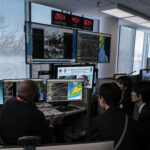ANCHORAGE, Alaska — Some Alaska residents received tsunami warnings on their cellphones following an earthquake earlier this week, including customers in the Anchorage area who were outside the potential danger zone.
There was no concern over a tsunami reaching Anchorage, more than 500 miles (805 kilometers) from the site where the magnitude 7.6 earthquake hit communities along the Alaska Peninsula coastline Monday, The Anchorage Daily News reported.
The cellphone warnings told people to move to high ground or inland away from coastal areas.
Overlapping boundaries within the chain of the emergency alert system caused the warnings to show up on some Anchorage phones, said National Oceanic and Atmospheric Administration Tsunami Warning Coordinator Dave Snider.
“Basically, the wireless alert zones don’t necessarily match with the weather service alert zones, which don’t match with state and federal alert zones,” Snider said. “And when you mash it all together, especially in that one spot, you get alerts going to many more people than are intended.”
The alert system pushing out emergency notifications to smartphones is complicated, said Jeremy Zidek of the Alaska Division of Homeland Security and Emergency Management.
The initial warning is generated by the National Weather Service and then passed to the Integrated Public Alert and Warning System platform operated by the Federal Emergency Management Agency.
The information is then shared with cellphone providers. Notifications are generated based on location and providers will ping users within a certain boundary or area in relation to a specific cellphone tower.
Some GCI customers likely received the emergency alert because the company has a cellphone tower near Anchorage that reaches customers along the Kenai Peninsula, GCI spokeswoman Heather Handyside said.
The alert Monday was intended to reach people on the Kenai Peninsula and any phones connecting to that tower would have received the warning.
The tsunami alert system is a “constantly evolving process,” Snider said.
“Tsunamis don’t happen often enough, like winter weather, for us to practice and rehearse and know what we’re dealing with, like when we get our snow tires on,” Snider said.
Was this article valuable?
Here are more articles you may enjoy.

 US Weather Service Merges Units as Staffing Pressure Rises
US Weather Service Merges Units as Staffing Pressure Rises  The Changing ADA Lawsuit Landscape: Things Claims Professionals Need to Know
The Changing ADA Lawsuit Landscape: Things Claims Professionals Need to Know  Hedge Funds Are Hunting Deals in Risks Too Big for Insurers
Hedge Funds Are Hunting Deals in Risks Too Big for Insurers  Fed’s Powell Says Tariff Impact Likely to Be Larger Than Expected
Fed’s Powell Says Tariff Impact Likely to Be Larger Than Expected 